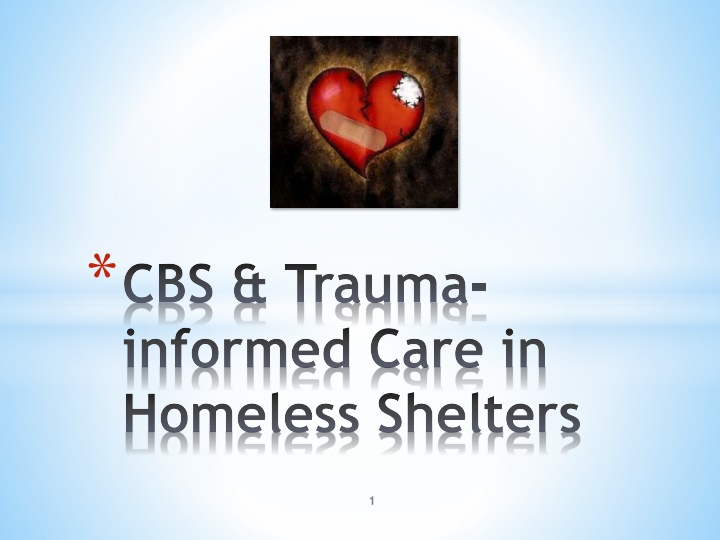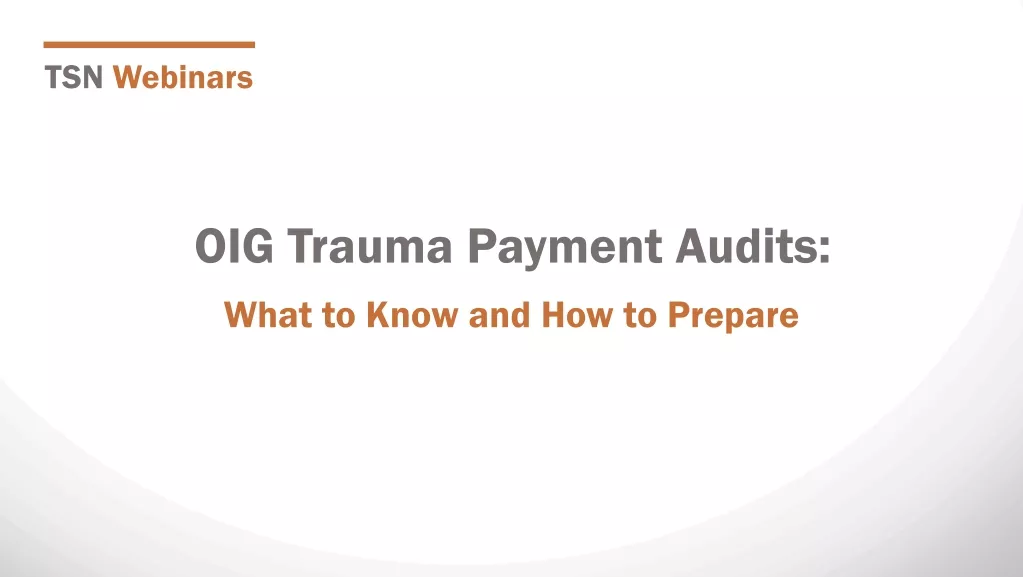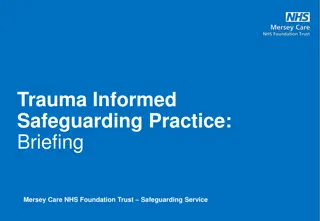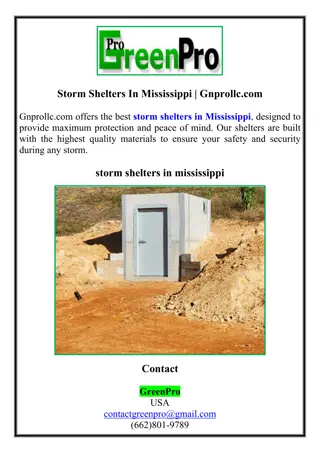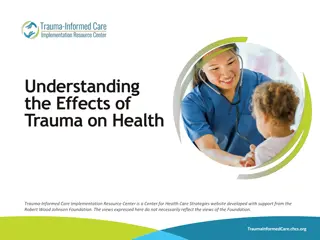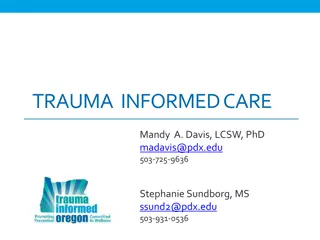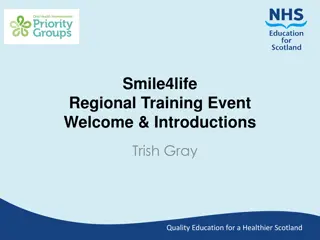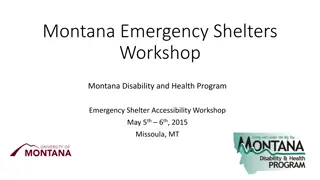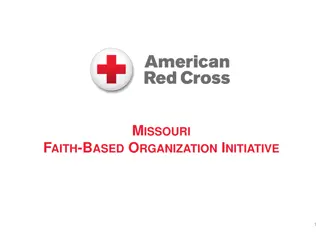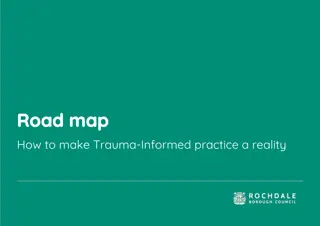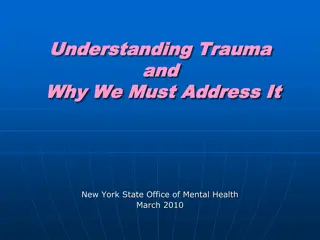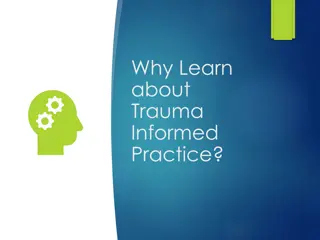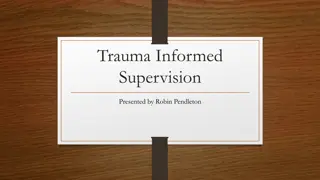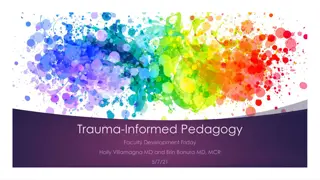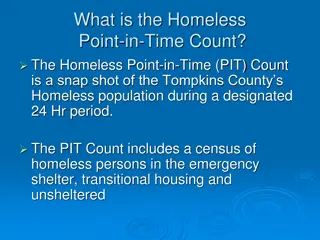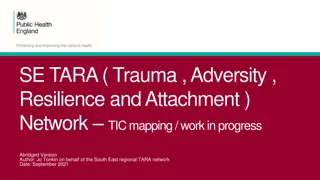Trauma-Informed Care in Homeless Shelters: A Critical Approach
Trauma-informed care involves a profound shift in perspective, recognizing the impact of trauma on individuals experiencing homelessness. The primary goals include raising awareness about trauma-influenced behaviors, preventing re-traumatization, and understanding the long-term effects of adverse childhood experiences. Explore the significance of the ACE Study in shedding light on the health and social implications of trauma and why trauma-informed care is crucial for vulnerable populations like the homeless in New York.
Uploaded on Feb 19, 2025 | 2 Views
Download Presentation

Please find below an Image/Link to download the presentation.
The content on the website is provided AS IS for your information and personal use only. It may not be sold, licensed, or shared on other websites without obtaining consent from the author.If you encounter any issues during the download, it is possible that the publisher has removed the file from their server.
You are allowed to download the files provided on this website for personal or commercial use, subject to the condition that they are used lawfully. All files are the property of their respective owners.
The content on the website is provided AS IS for your information and personal use only. It may not be sold, licensed, or shared on other websites without obtaining consent from the author.
E N D
Presentation Transcript
*CBS & Trauma- informed Care in Homeless Shelters 1
*Trauma-informed care is a mind-shift more than anything else *The primary aims of TIC are to: *Raise awareness that thorny presentations are usually trauma- impacted and are self-protective in nature *Trauma frequently impacts relationships and self-perpetuation of trauma cycles is common *Emphasize re-traumatization prevention as much as possible *What is TIC? 2
*ACE Study (1999): *Largest study of the short and long term impacts of cumulative childhood trauma *Over 17,000 HMO Members were interviewed and answered a series of very specific questions about their childhood experiences *Groundbreaking findings on health and social effects of adverse childhood experiences, with vast public health implications *Replication in 8 other states, as well as Norway, China, Japan, Jordan, the Phillippines, Canada, and the U.K. *What is TIC? 3
*ACE Study (1999): *Three types of abuse (sexual, physical and emotional). *Two types of neglect (physical and emotional). *Five types of family dysfunction (having a mother who was treated violently, a household member who s an alcoholic or drug user, who s been imprisoned, or diagnosed with mental illness, or parents who are separated or divorced *What is TIC? 4
ACE s increase the risk of: Heart Disease Chronic lung disease Liver disease Suicide Injuries HIV and STDs Depression Substance use & Alcoholism High blood pressure Heart attack Impaired memory Smoking Rape victimization Domestic violence (victim and perpetrator) Promiscuity (>50 partners) Unintended and/or teenage pregnancy Violence Hallucinations Severe Mental Illness Diabetes Obesity Anxiety *What is TIC? 5
*In New York: *95% of state hospital consumers *80% of the homeless *90% of women in jail *1600 veterans currently in homeless shelters or living on the streets *Why TIC? 6
*The challenge: *Transform two homeless shelters to become more trauma- informed *Do this in a system (NYC Dep t of Homelessness) that frequently expresses no interest in *Implementing TIC 7
*Evaluation *TIC-OSA *Incidents *ER visits *Length of Stay (?) *Implementing TIC 8
*Overview: *STEPS (safety, trauma-informed, empowerment, personal responsibility, strengths-based) materials *Lots of training of ALL staff * Healing Neen screenings *Leadership Team + Localized TIC committees *Peer to peer organizing *Consumer Advisory Committee *Increased communication with police & community *Implementing TIC 9
*Other considerations *Kickoff event w/ Tonier Cain *Intake process, welcome letter, peer orientation, etc *Implementing TIC 10
*Training included: *Mindfulness exercises seeing shelter life through the eyes of a woman (Anna) with a trauma-impacted history * and how she may respond/react to typical human responses to her oft-aggressive behavior *Exercises examining one s own (potential) trauma history *A step-by-step process to shift relational frame in response to thorny behaviors *Where Does CBS fit in? 11
*TREDS: *Take a breath / step back *Relationship focus *Empathic reflection *De-escalation *Supportive follow-up *Where Does CBS fit in? 12
*Take a breath / step back Gather yourself Orient yourself to the room Let go of any need for immediate resolution So you can focus on safety Look beyond the behavior to the hurt inside the person Do not take behavior personally *Where Does CBS fit in? 13
*Relationship focus Recognize that all interactions present an opportunity for healing *AVOID ARGUMENTS *Build and sustain trust *Communicate understanding and acceptance *Create safety and safe boundaries *Cultivation of positive relationships requires patience, sensitivity and a focus on the long view *Example: Getting into an argument will cause a power struggle and that s not helpful to anyone. In order to keep things safe, how about you and I talk about how we can work together here. *Where Does CBS fit in? 14
*Empathic reflection Identify and validate feelings by reflection Identify and validate self-protective behaviors Model safety, normalize and accept feelings Examples: You are feeling angry right now This is clearly important to you, and I d like to know more about it. However it s important we approach this in a safe way. *Where Does CBS fit in? 15
*De-escalation Safety and boundary setting Feedback Responsibility Choice Elicit willingness to do something different Example: I see you are upset. Our job right now is to make sure everyone is safe. You have choice here. We can sit and talk about what s happening, or you can continue to yell. I can t make this choice for you, but I can tell you that the safer option is the first one. At the end of the day, it s your decision. C mon let s try and figure this out together. *Where Does CBS fit in? 16
*Supportive Follow-Up * Focus on breaking the cycle of reactivity * Pro-active and persistent follow-up * Emphasize values * Addressing behaviors in a non-judgmental, trauma-informed way and in light of client s strengths and values * Psycho-education and the spirit of recovery * Example: Hey I just want to say that I m impressed by the choice that you made yesterday. How are you feeling about it today? * Example: Hey you are back. Can we check in for a minute? I want to see how you are feeling about the way things played out. Staff called 911 because it is crucial for everyone to feel safe. I m hoping that you understand this and I m wondering if next time you feel upset we can figure out some safer choices *Where Does CBS fit in? 17
*Across the two shelters (one year pre/post): *Statistically sig. increased fidelity in 3/7 TIC-OSA domains *24% reduction in psych ER visits *29% decrease in med ER visits *27% reduction in incidents involving physical aggression, property destruction *36% reduction in foyer/security area *51% decrease in staff reliance on EMS in response to incidents *20% decrease in staff reliance on police in response to incidents *189% increase in staff reliance on internal capacity to respond to incidents (neither police nor EMS called) *Results 18
*Anecdotal: *Increased engagement & relationship building *Increased peer to peer support, prevention *Increased staff retention *Results 19
*Looking forward: *Sustainment is critical & difficult *Improve relations with DHS *Results 20
